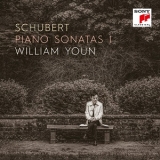 Franz Schubert: Klaviersonaten Vol. 1 (Klaviersonaten Nr. 1 D. 157 & Nr. 9 D. 571 / 604 / 570 & Nr. 13 D. 664 & Nr. 14 D. 784 & Nr. 21 D. 960); William Youn, Klavier; 2 CDs Sony Classical 19439784142; Aufnahmen 2019, Veröffentlichung 09/2020 (123'37) - Rezension von Remy Franck
Franz Schubert: Klaviersonaten Vol. 1 (Klaviersonaten Nr. 1 D. 157 & Nr. 9 D. 571 / 604 / 570 & Nr. 13 D. 664 & Nr. 14 D. 784 & Nr. 21 D. 960); William Youn, Klavier; 2 CDs Sony Classical 19439784142; Aufnahmen 2019, Veröffentlichung 09/2020 (123'37) - Rezension von Remy Franck
William Youn wendet sich nach Mozart nun Schubert zu. Auf der ersten CD dieses Albums stellt er die letzte und die erste Sonate gegenüber. Technisch brillant, mit größter deklamatorischer Klarheit und zudem gefühlvoll (aber ohne Pathos) durchwandert er die monumentale Sonate D. 960. Sorgfalt legt er dabei auf die Kontraste, die Brüche, die manchmal brutalen Stimmungswechsel.
Auch in den übrigen Sonaten zeigt sich Youn als feinfühliger Schubert-Interpret, der tief in die Musik eindringen kann und sie von innen ausleuchtet, mit feinsten Nuancen und faszinierenden Klangschattierungen. So macht er in der Ersten Sonate klar, wieviel verborgene Schönheit das junge Werk bereits enthält.
In den anderen Sonaten mischen sich ein angenehm leichtes und lichtvolles Spiel mit dramatischen Ausbrüchen, dunklem Grollen oder auch Kantabilität, innigem Lyrismus und atmender Poesie, so dass Schuberts zerrissene Gefühlswelt voll zum Ausdruck kommt.
Tatsächlich horcht Youn die Musik ungewöhnlich deutlich aus und erreicht so Augenblicke singulärer Ausdruckskunst, wo nichts übertrieben und nichts manieriert wirkt. Ein großartiger Auftakt einer Reihe, die uns gewiss noch viele bereichernde Darbietungen bringen wird.
After Mozart, William Youn now turns to Schubert. On the first CD of this album he juxtaposes the last and first sonata. In the great Sonata D. 960, his performance is technically brilliant, with the greatest declamatory clarity and also full of feeling, but without pathos. He pays careful attention to the contrasts, the breaks, the sometimes brutal mood changes.
In the other sonatas, too, Youn shows himself to be a sensitive Schubert interpreter who can penetrate deeply into the music and illuminate it from within, with the finest nuances, with fascinating shades of sound. In the First Sonata, for example, he makes it clear how much hidden beauty the young work already contains.
In the other sonatas, a pleasantly light and luminous playing is mixed with dramatic outbursts, dark rumbling or cantabile, intimate lyricism and breathing poetry, so that Schubert’s torn emotional world is fully expressed.
In fact, Youn listens to the music with unusual clarity, reaching moments of singular expressiveness where nothing seems exaggerated and nothing mannered. A great prelude to a series that will certainly bring us many more enriching performances.






















